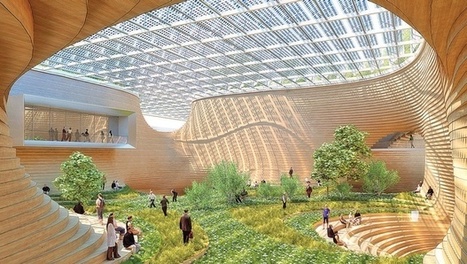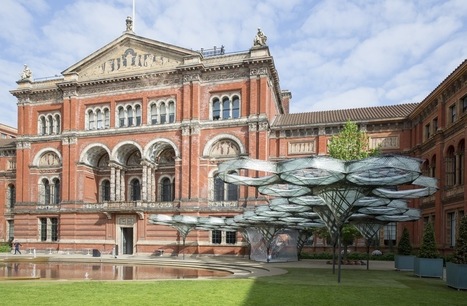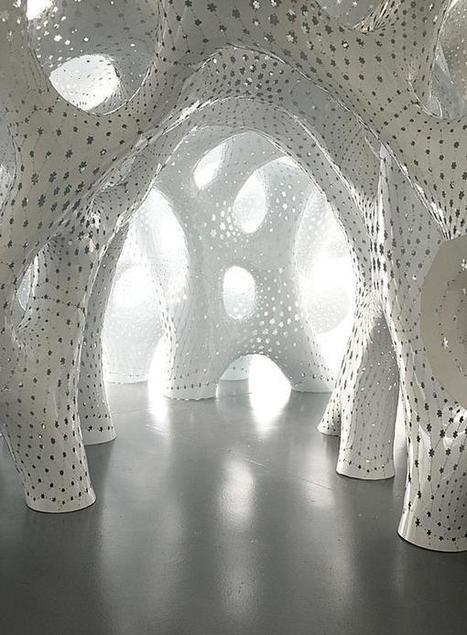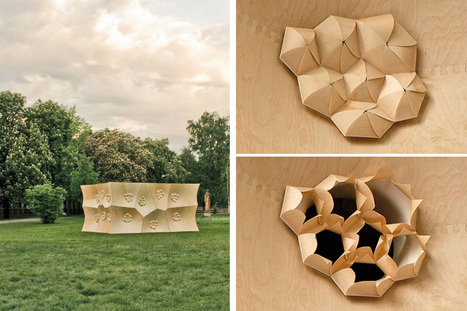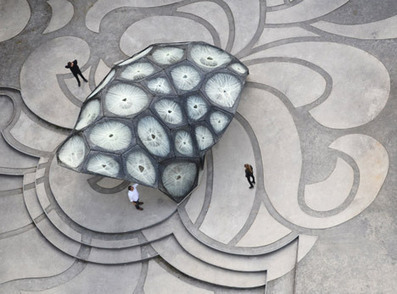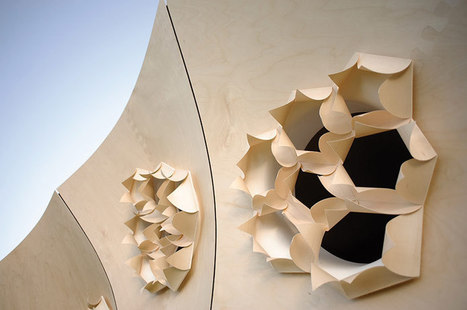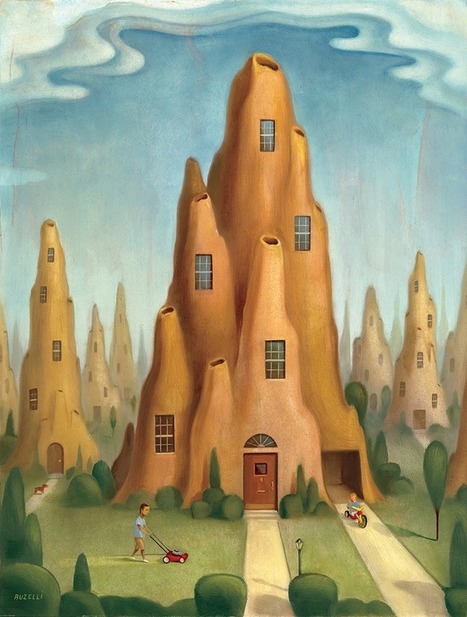 Your new post is loading...
 Your new post is loading...
"The team of architects Maryan Fazel and Belinda Ercan, from Iran and Germany, respectively, have won first prize in the competition for the design of the Moscow Circus School launched by the Architectural Competition Concours d’Architecture (AC-CA).
The winning proposal, entitled Elytra, is an “eye-catching, cutting-edge, [and] unconventional” design that will tower over Moscow’s Tverskoy District, an area which features a burgeoning artistic scene. Inspired by the forewings of insects—called elytra—the project opens upwards as a protective shell, and will feature both public and private space."
"UCL researchers have developed a revolutionary new type of ‘smart’ window which could cut window-cleaning costs in tall buildings while reducing heating bills and boosting worker productivity. The windows use nature inspired nanostructures which mimic the eyes of moths to cut glare, save energy and clean themselves."
"The Orchid, a source of life and symbol of sustainability and fecundity, is the inspiration for the shopping mall ‘Wooden Orchids’ designed by architect Vincent Callebaut. On the southern shore of the Yangtze river in China, Wooden Orchids is designed as an innovative solution to the main socio-economic problem – the rural exodus into super cities which causes undue stress on city resources. The project aims to create a new eco-responsible shopping and rich cultural experience, while maintaining it as a tourist destination that combines passive bioclimatic principles and renewable energy technology to assure 70 per cent energy saving. Based on biomimicry, the architecture of the shopping hub is directly inspired by the petals of an orchid flower and designed as repetition of a basic designed module. The site is divided into two lots, each in proportions of the golden section 1:1.618. The natural order of Fibonacci numbers, observed everywhere in nature, has been adopted to develop the hierarchy and flow of spaces and places, representing the right balance between solid and void, between shadow and light." ...
"During the last century and a half, humans have created cities that ignore natural cycles such as the weather and surrounding conditions, and have developed urban areas that have little to do with life in the natural world. The control of resources and mastery of energy sources has allowed us to become carelessly independent from our natural environment—which has led to a downward unsustainable path, currently incapable of supporting the massive population growth predicted for the world’s biggest cities. [...] Nature is holding sustainable solutions to numerous city design and development problems we are currently facing—we just have to look deeper to see where the solutions are already being applied in the natural world."
"Most of us were born and will die a certain color, but octopuses are masters of their hue, changing from transparent to shades of red, pink, purple and blue by stretching and relaxing their skin. If we could unlock their secret and wrap our buildings in octopus skin, then city skylines might shimmer a spectrum of colors and opacities as the sun waxed and waned."
"When urban infrastructure meets nature’s designers, amazing things can happen. More and more, biomimicry is being thought of as a way to reconsider the ways we build and operate cities. Today, these lessons are being actively applied in the realm of urban infrastructure and design in an effort to make places that are more sustainable, more livable, more intuitively designed and, at their core, more natural."
"Inside a bud, a flower’s petals lie in wait, a tight bundle of compressed tissue. When the conditions are right, they burst forth, blooming in an impressive display of geometry and color. During this opening period, which may last as long as 7 days or be as brief as 5 minutes, the cells that make up the petals may expand to 20 to 50 times their initial length. This great and relatively sudden inflation accounts for most of the flower’s shape. Some cells within the petal grow more than others and this differential growth is responsible for the 3D form of the petals. [...] Multi-material 3D printing may give us a way to incorporate such movements into the architecture of products and buildings. The provocatively named discipline of 4D-printing explores fabricating shape changing materials by means of 3D-printing. The differential growth of flowers suggests a way of designing such shape changing products."
"In recent years, architects, biologists, and engineers have been thinking about the possible connection the architectural field can have with living entities, such as insects or trees. Most of the time, architects design projects based on the imitation of natural forms. This imitation takes place in a field where there haven’t been previous studies about the organism being imitated, its basic organic functions, and its interaction with the environment. This concept is called biomorphism. When you add in concepts such as biomimicry and biomimetics as theoretical foundations, the design process is focused on the understanding of the functions of the project, how its functions and structure can be solved by studying a specific organism, and, in some supported research projects, how it can be built with parametric design."
"Ben-Gurion University of the Negev scientists have poured molten aluminum into a scorpion burrow and discovered that scorpion burrows have a platform on which to warm up before the evening hunt."
"Inspired by the valvular pollination mechanism of the Strelitzia Reginae flower (commonly known as the Bird-Of-Paradise) the Flectofin® is a hingeless louver system that is capable of shifting its fin 90 degrees by inducing bending stresses in the spine caused by displacement of a support or change of temperature in the lamina."
"Imagine a concert hall of coral rising like Atlantis from the sea. Or a data centre in the side of a mountain, complete with Bond villain subterranean lake. Exploration Architecture has produced designs for a restaurant on Old Street roundabout, and even started farming in the desert, but which is your favourite? The designs are all ‘biomimetic’ solutions; they all have mimicked nature to solve a human design problem. "
With balconies budding like leaves, no one could complain for lack of outdoor space in this building in France.
"HOK’s 2035 master plan for Bandar Seri Begawan in Brunei looks to the city’s original water-driven form for future inspiration. [...] The city rests at the intersection of three rivers, and is surrounded by the Borneo rainforest, but has suffered from a lack of cohesive direction."
|
“An elytron is very delicate and super lightweight, because after all, the beetle still needs to fly,” says Achim Menges, an architect and professor at the University of Stuttgart. “At the same time it’s very robust and exceptionally high performance.”
It was these elytra, the fibrous structures in the forewing shells of flying beetles, that inspired the Elytra Filament Pavilion.
From creating breathable metals to copying how animals cool their homes, architects and designers are increasingly using the principles of biomimicry in their work. Christopher DeWolf takes a look at how the discipline is evolving.
"Royal College of Art design student Chao Chen has developed a revolutionary new building material that responds to the presence of water. After observing the hydro-sensitive behavior of pine cones, which open and close depending upon their exposure to water, Chen has developed a wood laminate material that similarly bends and flexes in response to atmospheric humidity, soil moisture or rain. Applications for the technology include shelters that seal up when it rains and building cladding that opens to let in more light on a dull, drizzly day but closes to block out heat when the weather is hot and dry."
"A cactus (plural: cacti, cactuses, or cactus) is a member of the plant family Cactaceae, within the order Caryophyllales and is a succulent system that contains pressurised water that gives the organism structural stability as well as being a fundamental life source. Being a water-container, means that there is no need for other rigid structure such as bark to give structural performance against external loads. Water is an element already in compression and similar structural strategies have been derived from this natural phenomenon in man-made hydraulic structures."
"The rare blue morpho butterfly is among the largest butterflies in the world and one of the most spectacular with its brown wings that suddenly turn iridescent blue. This amazing display happens when blue light reflects off the layers of microscopic scales on its wings. 3M scientists studied the butterfly to mimic this effect in a window film."
The Eiffel Tower weighs less than the air around it. It achieves this by exploiting the same structural ideas that make your bones so strong yet so light.
"Biological systems often have the ability to adapt to their environments. They harness external atmospheric stimuli, and as a result, triggers are activated which might result in kinematic shape or chemical changes to a given system or plant. Performance challenges – when pitted against a series of resource limitations like humidity or lack of water – can provoke complex and multi-layered structural changes in plants, and nature regularly makes use of various strategies and materials to deal with those challenges.[...] University of Stuttgart Professor Achim Menges, a registered architect and the founding director of the Institute for Computational Design, is also a visiting professor in architecture at Harvard University, and his practice and research are devoted to creating integral design processes at the nexus of “morphogenetic design computation, biomimetic engineering and computer aided manufacturing."
Our reliance on air conditioning, however magical an innovation, has become a serious environmental burden. Which is why researchers in Barcelona designed a material they say can naturally cool rooms by about 5 degrees Celsius, using a moisture-absorbing polymer that "sweats" much like our own body.
A robotically woven carbon-fibre pavilion based on the lightweight shell encasing a beetle's wings and abdomen is revealed by the University of Stuttgart.
The Biotic-Tech Skyscraper City uses biomimicry and is inspired by squid, using transparency, flexibility, movement and protective pigmentation.
"Research on the spruce cone has led to a complex skin system that responds to localized climatic environments through the natural, mechanical properties of wood and humidity."
"In 1991, the multinational Old Mutual investment group approached the Zimbabwean architect Mick Pearce with an audacious assignment. The group wished to construct a retail and office complex called the Eastgate Centre in Zimbabwe’s capital city of Harare that, at 55,000 square meters, would be the country’s largest commercial building. What Old Mutual didn’t wish to do was pay the high cost of air-conditioning such a massive space. Could Pearce, working with the Arup construction firm, devise a design that relied solely on passive, natural climate control? Pondering the problem, Pearce found inspiration in the termite mounds that dotted the savannas across his country. "
|
 Your new post is loading...
Your new post is loading...
 Your new post is loading...
Your new post is loading...











